Interactive Video Ads that Engage Sports Fans
PUBLISH DATE: 13 February 2024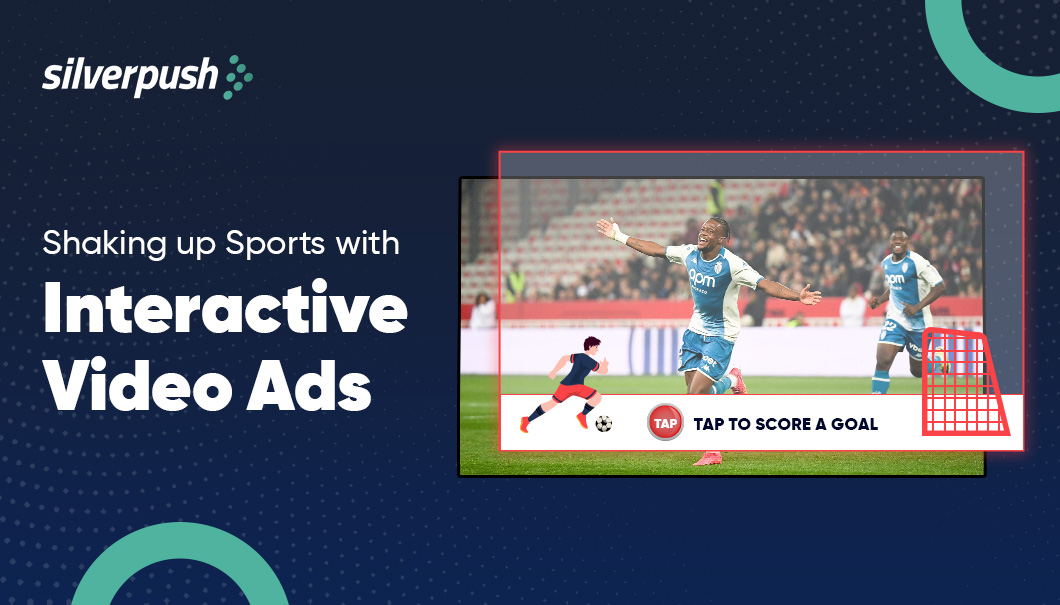
In today’s digital world, brands have a golden chance to shake things up in the sports industry with interactive video ads. Forget boring 15-second promos! Traditional video ads might work for movies and TV, but just like those industries, sports are going digital, and interactive ads are leading the charge. Viewers are tired of passive ads and want something engaging, that pulls them in and makes them want more.
Brands are realizing these fans are the perfect audience for interactive video ads. By adding games and ways for viewers to play along, these ads create a whole new experience that keeps people glued to the screen, coming back for more, and even tuning in live.
But that’s not all. Interactive video ads open a door to a whole new level of connection between brands and their target audience. By letting viewers interact, brands can gather valuable information about their preferences and habits, like what they like and how they behave. Incorporating elements of interactivity and gamification, these ads create an immersive experience that keeps viewers hooked, wanting more and tuning into live programming.
In this blog, let’s dive into the importance of sports marketing with some different types of interactive ad templates and see how sports brands can use them in their own campaigns!
Sports Marketing: Fans, Videos, & Winning Big Online
A study by Grand View Research, Inc. predicts that the global sports technology market is likely to achieve a substantial size of 55.14 billion USD by 2030, demonstrating an impressive (CAGR) of 20.8% from 2023 to 2030. This remarkable growth indicates the abundant opportunities within this dynamic and evolving landscape.
Sports teams used to promote themselves through megaphones and posters, but now they use the internet! Fans are online all the time, watching tons of sports stuff.
Videos are the biggest stars! Live streams let fans watch games and interviews live, even if they’re far away. Watching the winning shot on Facebook Live, feeling the excitement even through your phone! Teams also make short videos showing behind-the-scenes stuff or amazing player moments. These videos get people excited and make them feel closer to the team.
Also See: Sports Advertising Playbook
Leveling Up Advertising: Exploring Innovative Interactive Ad Templates
Interactive ads improve visibility & top of the mind recall while driving high impact through consumer engagement, multilingual marketing & retargeting. Let’s explore some of these templates:
Gamified Sports Experiences
Sports brands can create engaging mobile games aligned with popular sports themes. For example, a cricket-themed mobile game using phone’s motion sensors for realistic batting and bowling actions. Users could tap to start, choose heads or tails for the toss, and physically swing their phones to bat or bowl. This gamified experience not only entertained users but also aligned with their interests, creating a memorable interaction.
Real-Time Sports Data Integration
Integrating real-time sports data into interactive ads adds an immersive element. In a cricket-themed campaign, advanced sensors prompted users to shake their phones, simulating a ‘run out’ experience based on the live match scores. This sensory-rich approach leveraged the excitement of the game, providing users with a unique and interactive way to engage with the brand.
Contextual, Timely and Data-Driven Campaigns
Brands can optimize campaigns by incorporating timely and data-driven elements. An example involves a financial services promotion that dynamically featured live scores exclusively during matches. In the world of contextual & data driven advertising, brands can further optimize their campaigns through NLP analysis. NLP algorithms can analyze articles, newsletters related to finance.
By understanding the context of the text, brands can strategically place ads within relevant and brand-safe environments, ensuring that their promotions align with the thematic content and resonate with the intended audience. This ensures laser-focused targeting, capitalizing on the cricket buzz and effectively promoting the brand’s services during relevant moments.
Fitness-Centric Interactive Ads
Capitalize on the fitness zeitgeist by gamifying the user experience and fostering a sense of accomplishment. Brands can achieve this by developing interactive advertisements, such as virtual obstacle courses with leaderboards, that tap into users’ competitive nature and intrinsic desire for recognition. This strategic approach demonstrably increases user engagement, driving repeat interactions and solidifying your brand as a leader in the fitness space.
Discover: Crafters Creative Gallery
Score a Winning Play with Fans: Best Practices for Sports Brands in the Digital Age
Here are the best practices to unleash your inner MVP and score big with your passionate audience:
1. Personalized playbook: Use data-driven insights to understand your fans’ preferences, then tailor content and offers that resonate. Like exclusive behind-the-scenes footage for die-hards, or location-based discounts for regional supporters. Personalized experiences build deeper connections and make fans feel valued.
2. Content that Captivates: Craft engaging content that ignites emotions and sparks interaction. Think user-generated content campaigns, where fans become the stars. Or, unleash interactive quizzes and polls that get everyone buzzing. Remember, interactive content isn’t just about likes and shares – it’s about building a community of passionate fans.
3. AI Powered Precision: Go beyond basic targeting with AI enabled contextual targeting. This tech analyzes the content fans are consuming (videos, social media) and delivers ads that are relevant to their real-time interests. For instance, a fan reading an article about a rising rookie! They might see an ad for that player’s jersey right then and there. It’s like having a dedicated scout for each fan, ensuring every ad resonates, boosting engagement, and driving conversions.
4. Level Up the Fan Experience: Don’t just offer seats, offer portals! Embrace cutting-edge tech like gamification and AR/VR to create immersive experiences. Fans scoring virtual goals with their favorite players, or taking a virtual tour of the locker room.
These innovative touches leave lasting impressions and make your brand the ultimate destination for die-hard enthusiasts.
The Importance of Responsible AI in Video Advertising
PUBLISH DATE: 12 February 2024
Artificial Intelligence, aka AI, has become one of the most talked-about topics in recent years. Each day brings forth new AI technologies, with some already seamlessly integrating into our daily lives. The advertising industry, in particular, is experiencing a significant impact as AI, or its earlier iterations has been quietly working behind the scenes in automated systems for quite some time. However, there is a noticeable shift as AI is now making its presence felt in more overt and prominent ways.
- 54.5% of advertisers say AI will most likely greatly enhance their marketing efforts.
- 61.4% of marketers have used AI in their marketing activities.
- 19.2% of marketers spent more than 40% of their marketing budget on AI-driven campaigns.
Source: From Influencer Marketing Hub 2023
While AI usage is growing, advertising professionals are very aware of the challenges the technologies pose.
AI Presents Diverse Use Cases for Advertising Professionals
1. Data Analysis
2. Content Generation
3. Natural Language Processing (NLP)
3. Media Buying
4. Real-time Personalization
5. Enhanced Targeting
6. Automated Decision-Making
The adoption of artificial intelligence (AI) is revolutionizing a brand’s advertising operations, providing advertisers with unparalleled insights into consumer behavior and the opportunity to create customized solutions, products, and experiences. Yet, as we strive for innovation and efficiency, it is crucial to pause and contemplate the pivotal role of ethics in this AI-driven landscape.
Navigating the Video Advertising Landscape: The Crucial Role of Responsible AI
As AI continues to wield its influence, responsible practices become imperative to mitigate potential risks and foster a trustworthy advertising ecosystem. Responsible AI in video advertising involves aligning technological advancements with ethical considerations, ensuring that the benefits are distributed equitably and that potential biases are identified and addressed.
At its core, Responsible AI revolves around the use and development of AI algorithms that align with human principles and societal values. The primary aim is to guarantee that AI is designed and applied with key principles in mind: fairness, reliability, privacy, inclusiveness, and transparency. This approach ensures a balanced and ethical integration of AI technology into our lives.
Transparency
Transparency is the core principle of AI-powered advertising strategies. To ensure ethical AI practices it is important to safeguard these cornerstones. 77% of consumers are more likely to trust companies that have ethical use of AI policies, according to global research. Transparency isn’t a buzzword in the advertising industry. It is the key to building deeper and meaningful relationships with the target audience.
Privacy and Data Protection
Privacy and Data protection have been the constant concerns in the advertising ecosystem. With Generative AI capabilities advertisers must be vigilant in handling vast data sets/ Obtaining explicit consent for data usage and adhering to robust data protection regulations are the essential practices.
Additionally, advertisers must be careful of the biases as predictive text leverages historical data. Advertisers must deeply analyze and audit the AI system to identify and rectify the bias.
A significant 81% of Chief Marketing Officers (CMOs) express the belief that regulating generative AI is essential. This underscores the importance of approaching the implementation of AI technologies with careful consideration and a commitment to responsible practices.
The Road Ahead: Balancing Innovation and Ethics with Human Expertise
While Artificial Intelligence is a powerful tool, the integration of human expertise remains essential for advertisers to navigate the complexity of contextual nuances, ensure brand alignment, and address unforeseen challenges in the dynamic digital landscape.
Ethical Considerations in AI Development:
While AI algorithms can automate decision-making processes and optimize content delivery, it is essential to embed ethical considerations into the very fabric of AI development. Human experts play a pivotal role in defining ethical guidelines, identifying potential biases, and ensuring that the algorithms align with societal values. Striking a balance between technological advancement and ethical boundaries requires the expertise of those who can navigate the nuanced landscape of human values and cultural norms.
Human Oversight for Algorithmic Accountability:
Even the most advanced AI algorithms are not infallible. Human expertise is indispensable in providing oversight and accountability. Human experts can monitor algorithmic outputs, identify unintended consequences, and intervene when necessary to rectify biases or ethical lapses. This human touch ensures a level of transparency and accountability that machines alone cannot provide.
Understanding Context and Nuances:
Human expertise brings an understanding of context and nuances that are often challenging for AI systems to grasp fully. While algorithms excel at processing vast amounts of data, human experts can interpret cultural, social, and contextual subtleties that impact the effectiveness and appropriateness of video advertising. Striking the right balance between innovation and ethical considerations requires a deep understanding of the human experience, something that AI, as of now, cannot fully replicate.
Adapting to Evolving Ethical Standards:
Ethical standards evolve with societal changes, and human expertise is crucial in adapting AI systems to these shifts. Human experts can analyze the evolving ethical landscape, update algorithms accordingly, and ensure that video advertising practices remain aligned with the values and expectations of the target audience.
Maintaining Creativity and Emotional Intelligence:
While AI can analyze data and make predictions, it lacks the innate creativity and emotional intelligence that humans bring to the advertising industry. Crafting compelling and emotionally resonant content often requires human intuition, cultural understanding, and the ability to connect with diverse audiences on a personal level.
Conclusion
In conclusion, we can say that AI will play a vital role in advertising operations and advertisers need to be highly skilled to maintain data privacy, trust, safety, and high standards of advertising.
Contextual Video Advertising: Tentpole Events Calendar for 2024
PUBLISH DATE: 25 January 2024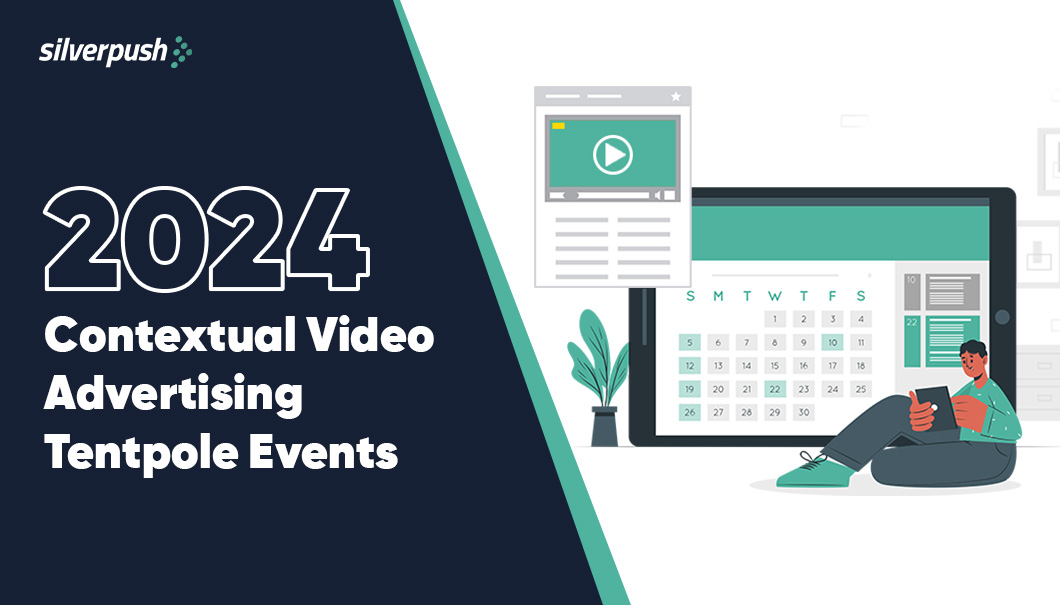
As we step into a post-cookie ad tech era, contextual advertising is poised to take center stage, becoming a pivotal strategy for brands aiming to connect with consumers through privacy-compliant and contextually relevant approaches. Marketers and advertisers are seeking to connect with new and relevant audiences by utilizing contextual advertising for video through ad tech companies like Silverpush.
With a wealth of experience and a continually expanding team of experts, Silverpush stands as a leading global provider of contextual video advertising solutions. In the dynamic landscape of video advertising, the prominence of contextual advertising is on the rise, emphasizing the critical need to embrace this innovative targeting strategy. Silverpush is dedicated to assisting global brands in realizing their objectives in ad viewability and brand safety, surpassing conventional ad methods.
If you’re looking to delve into contextual video advertising in 2024, it’s advisable to focus on campaigns centered around key tentpole events in 2024. These tentpole marketing events traditionally offer heightened visibility for brands seeking active engagement with major news and lifestyle stories. Capitalizing on these moments can amplify the impact of contextual video advertising, creating strategic opportunities for brands to connect with their target audience amid significant cultural and societal events.
Calendar of Pivotal Tentpole Events for Advertisers in 2024
Holidays & Events in Q1 2024 (January, February, March)
As the new year unfolds, a tapestry of traditional narratives and events emerges, featuring stories of New Year’s resolutions, and various lifestyle milestones. Simultaneously, the season ushers in major sporting spectacles like the Superbowl, March Madness, and the Winter Olympics. Noteworthy advertising calendar events 2024 include Black History Month in February and Women’s History Month in March, offering advertisers key opportunities to align their campaigns with these cultural and historical moments.
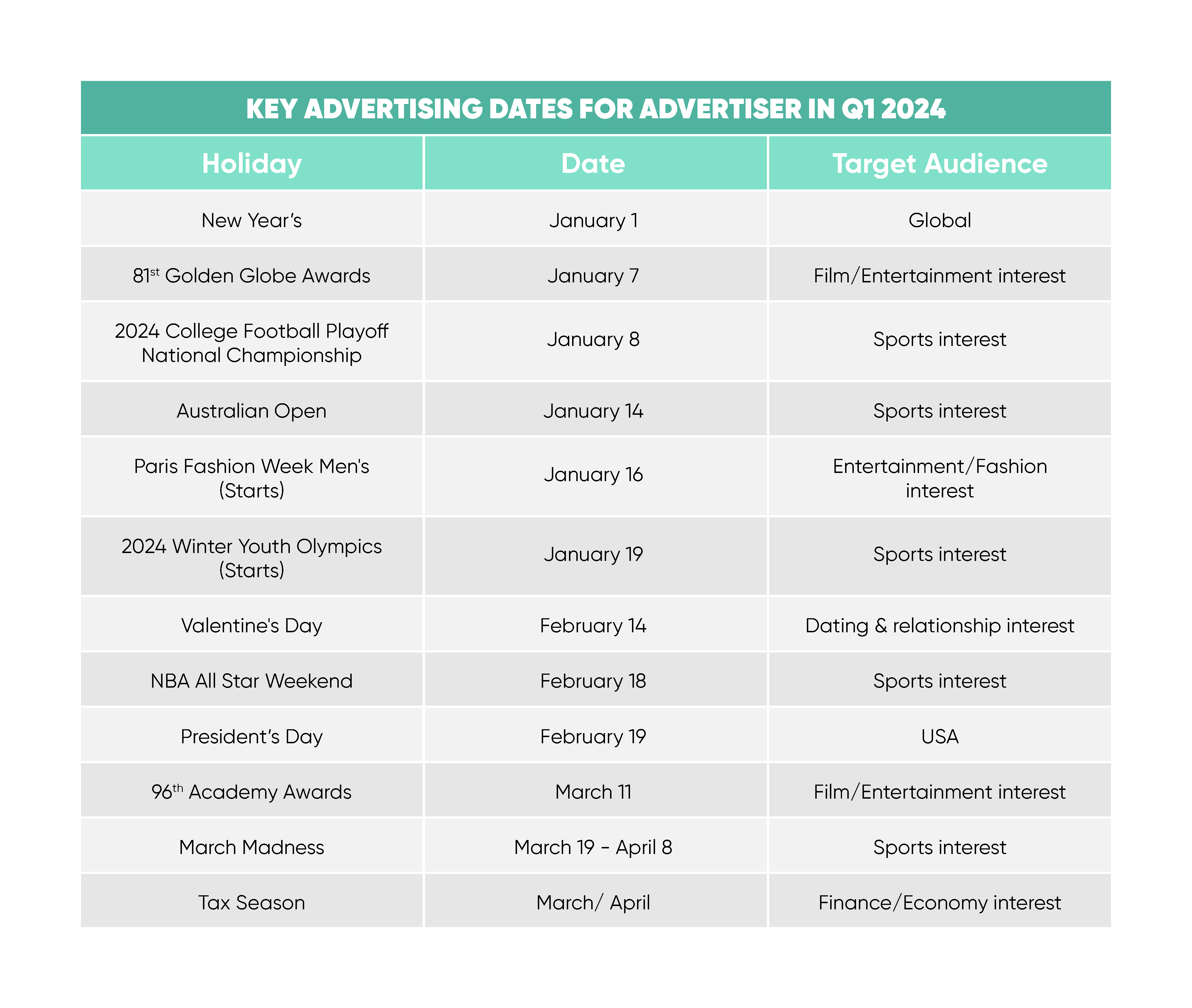
Holidays & Events in Q2 2024 (April, May, June)
Spring brings forth several significant tentpole events and global seasonal holidays, creating ample opportunities for advertisers. Lifestyle celebrations like Mother’s Day and Father’s Day, alongside commercial observances such as Memorial Day, Easter, Prime Day, graduation ceremonies, and to some extent, Pride Month, contribute to a bustling season for marketers. Leveraging contextual targeting allows advertisers to tap into these segments, potentially reaching millions of impressions.
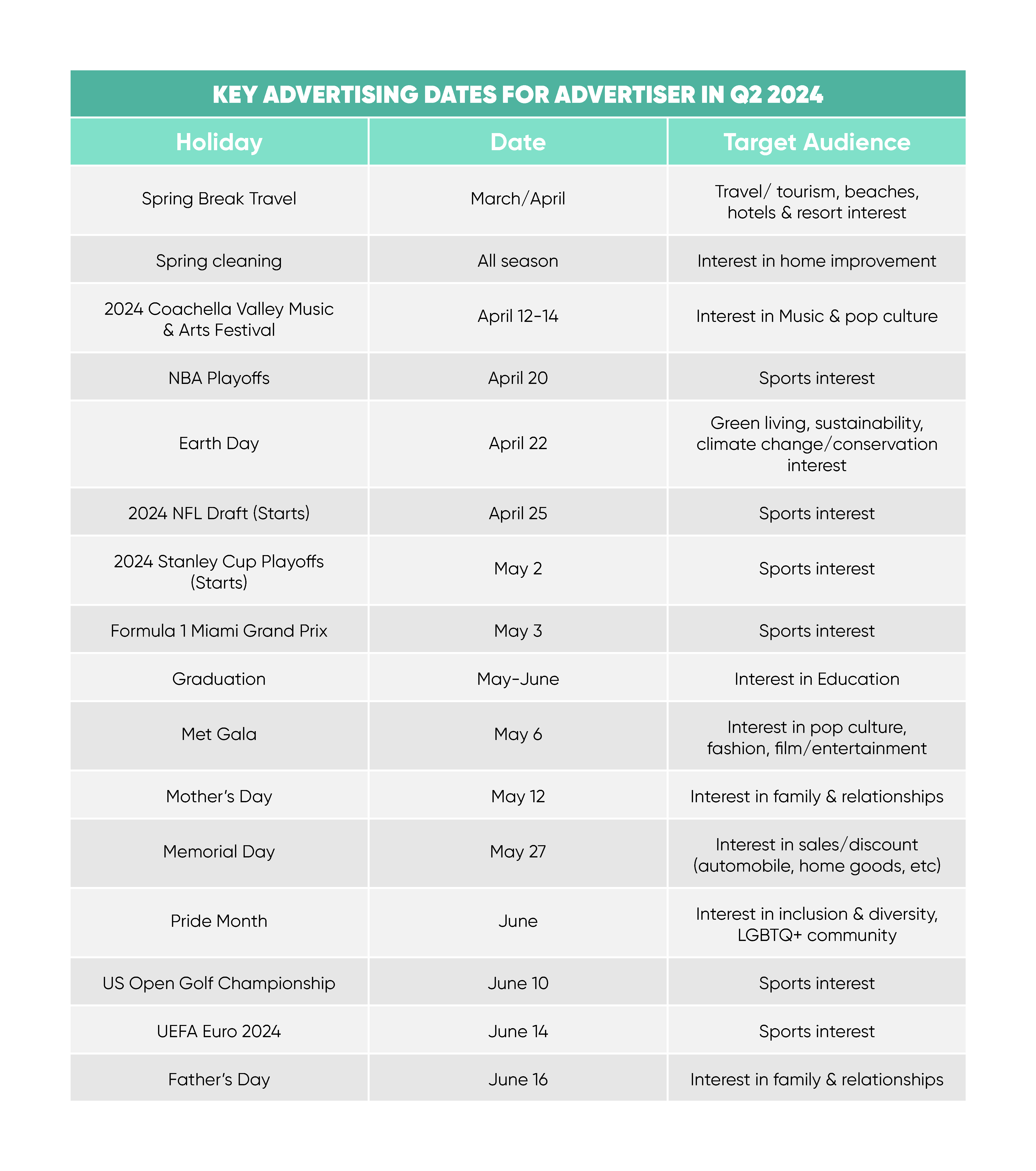
Holidays & Events in Q3 2024 (July, August, September)
While the summer season may experience a dip in web and e-commerce traffic, strategic advertising opportunities arise during significant events such as the 4th of July, Amazon Prime Day, and the back-to-school sales around Labor Day.
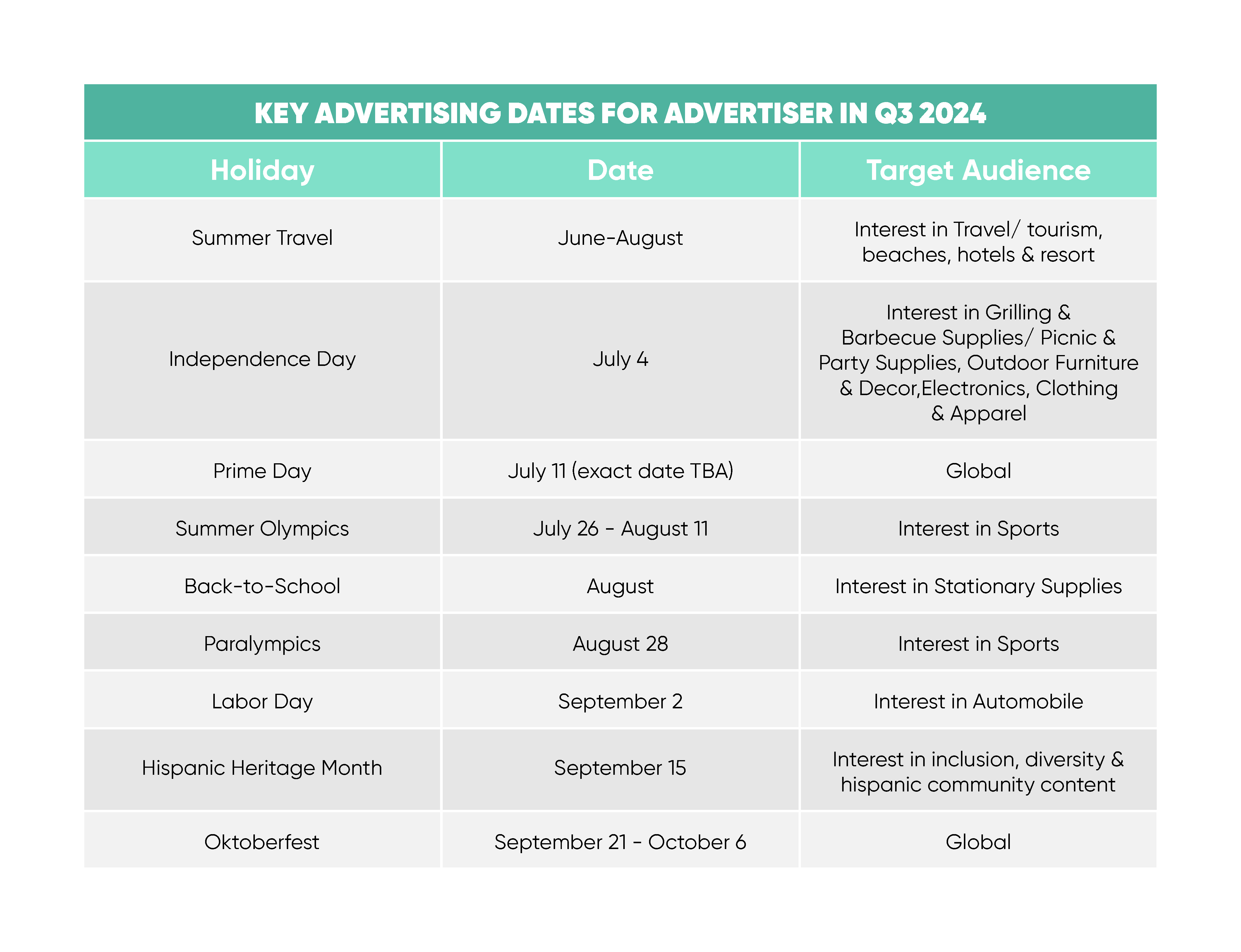
Holidays & Events in Q4 2024 (October, November, December)
It’s evident that the fourth quarter (Q4) of the year, encompassing the holiday season, is a crucial period for online advertising. Advertisers often intensify their efforts during this time to capitalize on the increased consumer spending associated with holiday shopping. The use of contextual targeting strategies adds a layer of sophistication to campaigns, allowing advertisers to optimize for brand safety and ad viewability strategically.
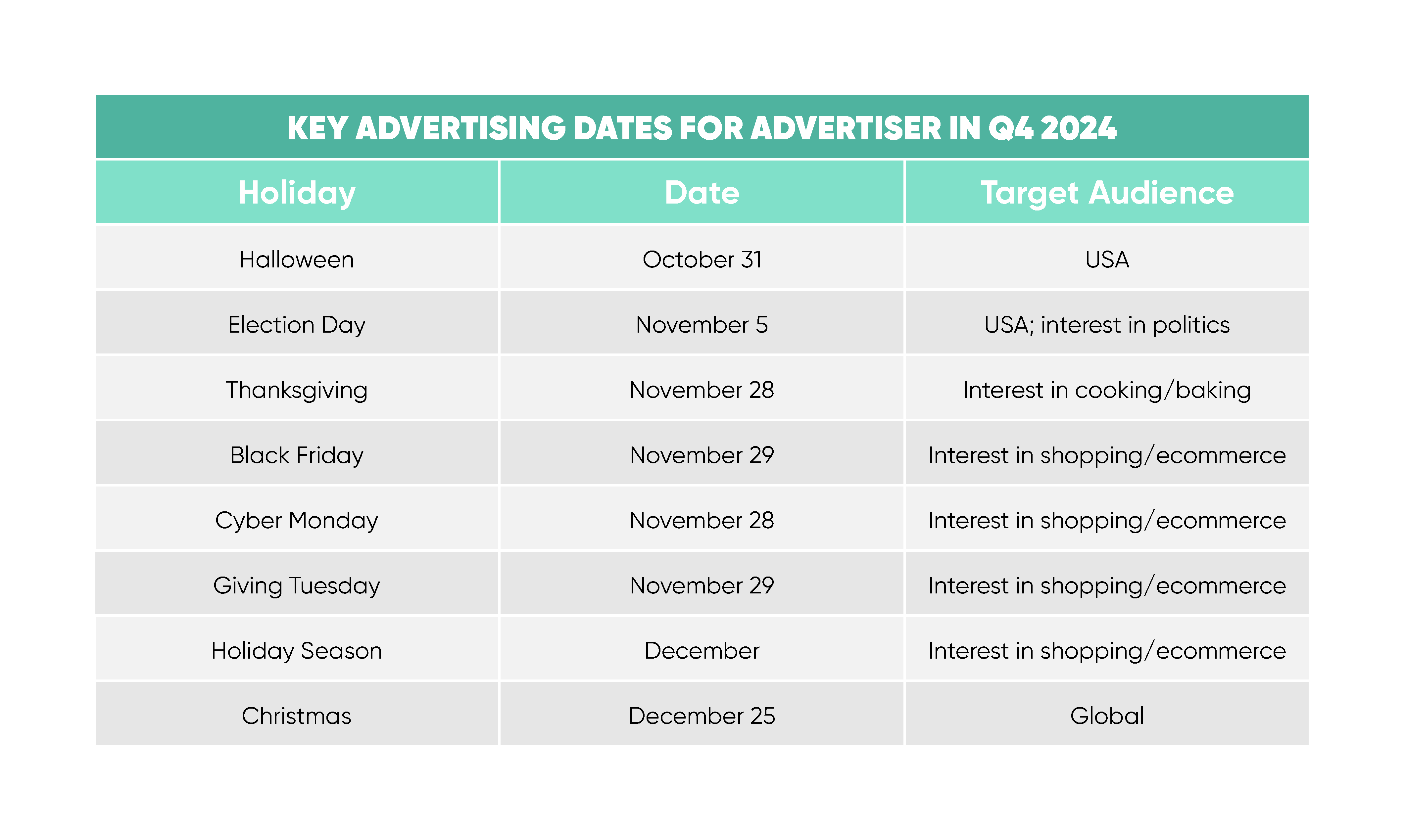
Watch a recent case study involving a major soft beverage company that collaborated with Silverpush, resulting in a remarkable 1.7x increase in VTR.
For more information on ad targeting and strategies to optimize your campaigns, reach out to us.
Good things DO NOT come to those who wait
PUBLISH DATE: 18 January 2024
In the fast-paced world of advertising, the saying “Good things come to those who wait” couldn’t be further from the truth. In an era where technology evolves rapidly, and consumer behavior constantly shifts, advertisers clinging to outdated and monotonous campaign strategies may find themselves drifting away from valuable business opportunities.
Discover the Trends Taking Over in 2024
As we step into 2024, it becomes imperative for advertisers to discern and leverage key trends to maintain a competitive edge in this dynamic arena.
Brace yourself for the cookie countdown
The global digital advertising market was valued at $601.8 billion in 2023, with media ads accounting for 67.1% of overall expenditure. Clearly, digital advertising is a lucrative industry, and it’s no surprise that more companies are finding ways to capitalize on this trend. However, as more companies seek to tap into this thriving trend, it’s essential to address the impending challenge of cookie deprecation and its potential impact on advertisers and digital advertising revenue.
Google has outlined its plan to phase out third-party cookies entirely by the conclusion of 2024, and efforts are already underway to implement this transition. The initial measure involves the introduction of Privacy Sandbox Tracking Protection, which will be experienced by 1% of Chrome users globally. This feature aims to restrict cross-site tracking by default.
Focus will be more on Personalization and Hyper-Targeting
“One-size-fits-all” approach won’t be effective anymore. With abundance of information and choices consumers today expect to be catered with relevant ads, they want brands to directly speak to them based on their interests, needs and preferences.
70% of consumers expect personalization and 56% agreed that personalized experience motivates them to become a repeat customer. (Source)
From a business point of view, personalisation helped 77% of businesses increase their market share. This form of marketing has increased conversions nearly 50% for brands. (Source)
Brands that don’t invest in understanding their audience and delivering tailored content are at the risk of losing customer engagement.
Video Content Dominance
Video content will continue to dominate the existing ad formats, as billions of viewers tune in. According to stats, 2023 had seen a 23% surge in internet traffic volume globally, escalating usage of streaming videos. (source)
But, advertisers need to be mindful of the video length, as consumer attention span and patience is getting shorter. More than 25% of adults close a video after 10 seconds and approximately 50% of the viewers close it after 20 seconds. (source)
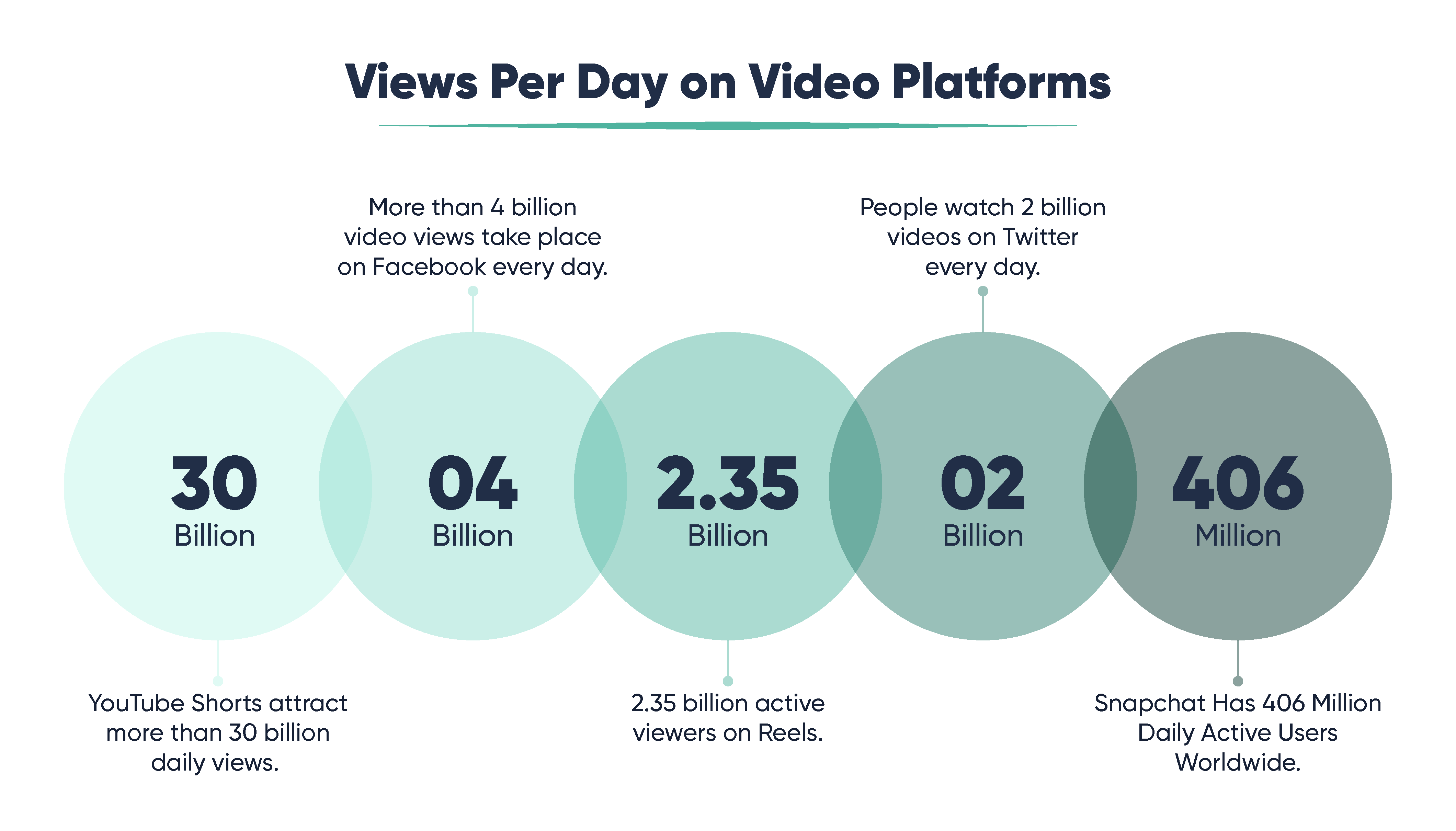
Brands should focus on creating high-quality and engaging video content for platforms like YouTube, TikTok, and Instagram. This trend is especially important as attention spans decrease, and visual storytelling becomes more critical.
Interactive Content
Since video content is gaining popularity advertisers need to advance their video advertising strategies. From the traditional video ads there is going to be an upgrade to dynamic interactive video ads.
To drive more engagement and conversion, advertisers should incline towards dynamic video ads as a result they have noted significant growth in their online sales.
Interactive content, such as polls, quizzes, and augmented reality experiences, not only captures attention but also provides a more immersive brand experience.
Among the interactive elements, shoppable TV ads have proven to be highly effective for cutting through the noise and boosting customer engagement due to their interactive nature. According to a survey, Shoppable ads have 55% ad recall and 50% interacting rate.
Role of Generative AI
Generative AI can process large amounts of data and generate valuable insights that can inform strategic decisions in campaign planning. Additionally, AI algorithms can analyze diverse datasets to identify and create new audience segments. Using these insights, advertisers can tailor their campaigns to specific demographics, ensuring more targeted and effective advertising.
Advertisers are using predictive analytics to analyze historical data and gain insights into user behavior, enabling them to optimize their campaigns further.
Conclusion
The advertising industry heavily relies on AI for campaign planning, execution, and optimization. Generative AI is changing the game by actively participating in the process. To achieve maximum success, brands should stay up-to-date with the latest trends in advertising and incorporate generative AI into their campaigns. This will provide advertisers with unparalleled levels of data analysis, audience segmentation, and dynamic content creation, leading to more efficient and personalized targeted advertising that can significantly boost the impact of campaigns. In a constantly evolving landscape, innovation is crucial to maintain growth and market dominance. Brands that embrace the potential of generative AI and adapt their strategies accordingly can exceed the expectations of the ever-changing consumer base. This will ensure a prosperous future in the dynamic world of advertising.
Safe and Sound: Building a Fortified Online Presence for Your Brand
PUBLISH DATE: 26 December 2023
In the digital age, where a brand’s reputation is built and broken online, brand safety has emerged as a critical business imperative. It goes beyond simply avoiding harmful content; it’s about strategically managing your brand’s online presence and ensuring it appears in environments that are aligned with your values, resonate with your target audience, and ultimately contribute to your overall business goals.
What is Brand Safety?
In essence, brand safety encompasses a set of measures, guidelines, and practices to ensure that a brand’s advertising does not appear in contexts that could potentially harm its image. This is especially crucial in the world of digital advertising, where programmatic placements might lead to ads appearing alongside off-brand, offensive, or controversial content.
Brand safety is a paramount concern for advertisers today, focusing on safeguarding the reputation of their brands and preventing them from associating with negative environments. The Global Alliance for Responsible Media (GARM) has developed the GARM: Brand Safety Floor + Suitability Framework to aid brands in maintaining their reputation by avoiding harmful or inappropriate content.
Critical components of brand safety include:
- Contextual Relevance: Guaranteeing that ad content is not only appropriate but also relevant to the content of the webpage, video, or other media in which it is displayed.
- Quality of Placement: Ensuring that ads are featured on websites or media outlets that align with the brand’s values and quality standards.
- Content Exclusions: Employing negative keyword lists, blocklists, or other filtering tools to prevent ads from being displayed next to specific types of content.
- Compliance and Regulation: Ensuring that ad placements adhere to industry regulations, which may vary by country, encompassing guidelines on advertising for products like tobacco, alcohol, or pharmaceuticals.
- Audience Targeting: Confirming that ads are directed at a demographic that is not only suitable but also intended for the advertised product or service.
Why Does it Matter?
Imagine your brand’s carefully crafted ad appearing next to a controversial news article or an offensive video. The resulting damage to your brand image could be significant, leading to lost sales, customer churn, and a negative public perception.
A 2021 US survey revealed that 80% of respondents expressed concern about brands appearing alongside negative content online. This statistic underscores the importance of brand safety for businesses of all sizes, regardless of industry or target audience.

Several factors pose significant risks to brand safety in the ever-evolving digital landscape:
1. The Social Media Frontier: Over time, social media has become a globally acknowledged source of truth. A well-crafted social media presence plays a crucial role in establishing a brand’s identity. Individuals prefer staying informed and closely monitoring their favored brands on social platforms. However, the dual nature of social media poses both advantages and challenges.
While it serves as an excellent avenue for brand promotion and interaction with customers and enthusiasts, it also carries the risk of brand reputation damage if ads appear alongside objectionable content. This powerful tool’s accessibility has led to instances where internet users have criticized brands for inappropriate content, imagery, or placement next to questionable material or pages.
To ensure brand safety, meticulous attention is required in areas such as ad strategy, and monitoring mentions, comments, and appearances. Marketers must remain vigilant against impostors and identity thieves capable of causing significant harm through fraudulent activities or posting unsavory content.
2. The Perils of Ad Fraud: In an industry valued at over US$ 640 billion, fraudulent activities are inevitable. Dubious websites, often assisted by bots, generate false clicks and attract ads, leading to significant financial losses for advertisers every month. It is imperative for marketers to ascertain whether their ads genuinely reach the intended audience, exercise control over ad impressions, and measure the quality of impressions and clicks.
The impact on brand safety is notable, with adult websites being a major contributor to ad fraud. An esteemed brand’s ad appearing alongside adult content can severely damage its image. While keyword block lists are useful, they alone cannot guarantee brand safety, and the practice may have unintended consequences.
3. The Pitfall of Poor Ad Placement: Ad placements are not just about reaching a large audience; they are about ensuring your brand appears in the right context. Placing ads on websites that are inconsistent with your brand values or target audience can lead to negative associations and erode your brand image.
A common mistake among marketers and advertisers is the oversight of ad placement strategy. Reports have criticized YouTube for displaying ads from renowned brands alongside misinformation and conspiratorial content. Emphasizing the importance of ad placements is crucial, as they significantly impact a brand’s image.
Striking the Perfect Balance of Brand Safety with Contextual
Contextual targeting offers a powerful solution to the challenges of brand safety. This innovative technology utilizes artificial intelligence, including Natural Language Processing (NLP) and Sentiment Analysis, to understand the context of web pages and online environments. By analyzing the written and visual content, contextual targeting enables brands to place their ads on relevant websites with content that aligns with their brand values and resonates with their target audience.
Mirrors by Silverpush: Your Trusted Partner in Brand Safety

Mirrors by Silverpush is a cutting-edge contextual targeting platform designed to help brands achieve their goals while maintaining the highest levels of brand safety. Utilizing sophisticated AI algorithms and advanced language models, Mirrors analyzes the written and visual content of web pages, ensuring that your ads appear in safe and brand-aligned environments. With Mirrors, you can:
- Protect your brand reputation through intelligent ad placement.
- Reach your target audience with precision and relevance.
- Gain valuable insights into your audience’s behavior and preferences.
- Optimize your campaigns for maximum effectiveness and return on investment.
In conclusion, brand safety is no longer a luxury; it’s a necessity for businesses operating in the digital world. Innovative solutions like contextual targeting and partnering with trusted solutions like Mirrors, brands can ensure their reputation is safeguarded, their advertising efforts are effective, and their overall business objectives are achieved.
Contextual Isn’t New, but Advancements Will Solve Marketers’ Headaches
PUBLISH DATE: 13 December 2023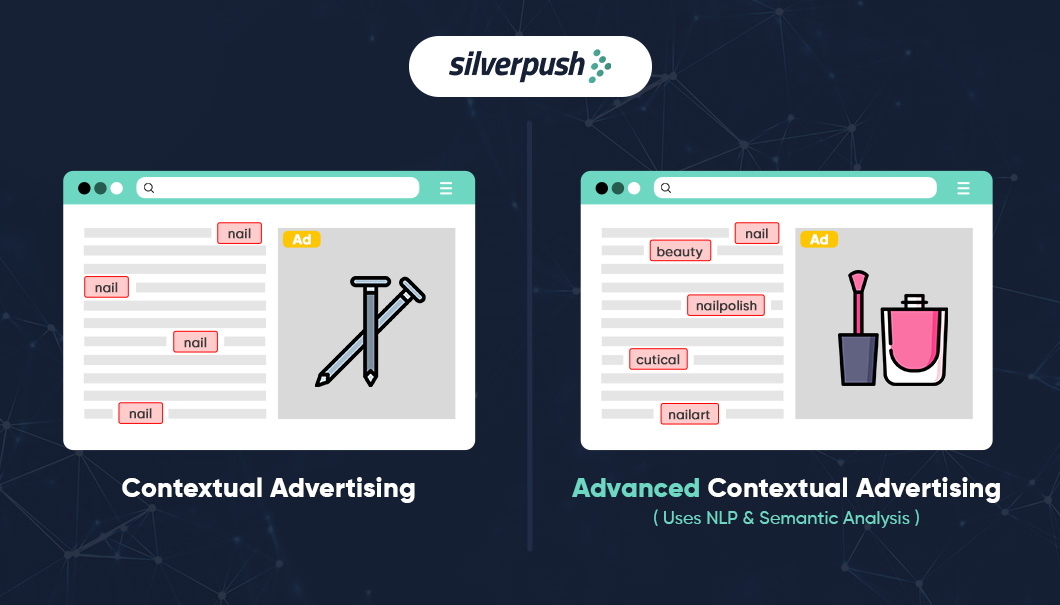
Contextual advertising is on the surge, according to projection it will reach 427.40 billion by 2029.
Since 2018, the advertising landscape has been under the seismic shift. Privacy centric shifts in the form of guidelines by GDPR and CCPA and initiatives by Apple and Android have become the talk of the town.
After banning third-party cookies from Safari, Apple launched its App Tracking Transparency in 2021. With ATT in the picture, apps are required to obtain explicit user consent before tracking their activity.
Similar action was taken by Android OS in 2023 where they launched the beta version of Android Privacy Sandbox. Google is working on a strategic phase-out of the cookies by 2024.
This was just a background picture of how contextual advertising gained limelight once again!
Advertisers turned to contextual targeting as it was easy and offered compliant targeting at scale. But this approach came with its own set of challenges.
Drawbacks of the Existing Contextual Approach
The conventional contextual advertising relies on the understanding of the environment in which the ad is displayed. The traditional method of contextual targeting was limited to the placement of ads based on the webpage content. This was primarily done by analyzing the keywords of the webpage.

Traditional approach is relatively simple and straightforward but it lacked in reaching the consumer who would be actively interested. Other challenges that occurred with traditional contextual advertising were:
- Imprecision: The understanding of the page’s content was limited which sometimes resulted in the irrelevant ad placement.
- Reach: The reach was a significant issue with traditional approach as it lacked granular targeting and often missed the active users who would have been interested in the ad. Traditional contextual advertising often struggles to reach a sufficiently large audience due to the following factors:
- Scalability: Scalability is a major challenge in traditional contextual advertising due to the sheer volume of web pages and the need for real-time ad placement. Traditional contextual advertising relies on manual analysis of webpage content to determine its relevance for ad placement. This process is extremely time-consuming and labor-intensive, making it impractical for handling the vast amount of content that exists online.
AI-Powered Contextual Advertising: Smarter Targeting Approach in Privacy-First Era
The advent of AI-powered contextual targeting has marked a significant shift. In leveraging technology, advertisers now have the means to overcome these challenges. This innovative approach enables a more nuanced understanding of content, ensuring precise targeting, broader reach, and improved scalability, thereby revolutionizing the effectiveness of contextual advertising in the contemporary advertising landscape.
Contextual Advertising Re-engineered as Targeting Approach
The acceleration of the new generation of contextual advertising can be attributed to the evolution of machine learning and artificial intelligence (AI). In navigating the challenges posed by stringent data regulations, AI-powered contextual solutions play a pivotal role in shaping the success or failure of advertising endeavors.
Advanced contextual targeting, fueled by natural language processing (NLP), semantic analysis, and machine learning, has emerged as a game-changer. By delving deeper into content, context, and user intent, it effectively addresses issues of scalability, reach, and imprecision. The re-engineered contextual advertising paradigm prioritizes data acquisition, empowering advertisers with data-driven targeting solutions.
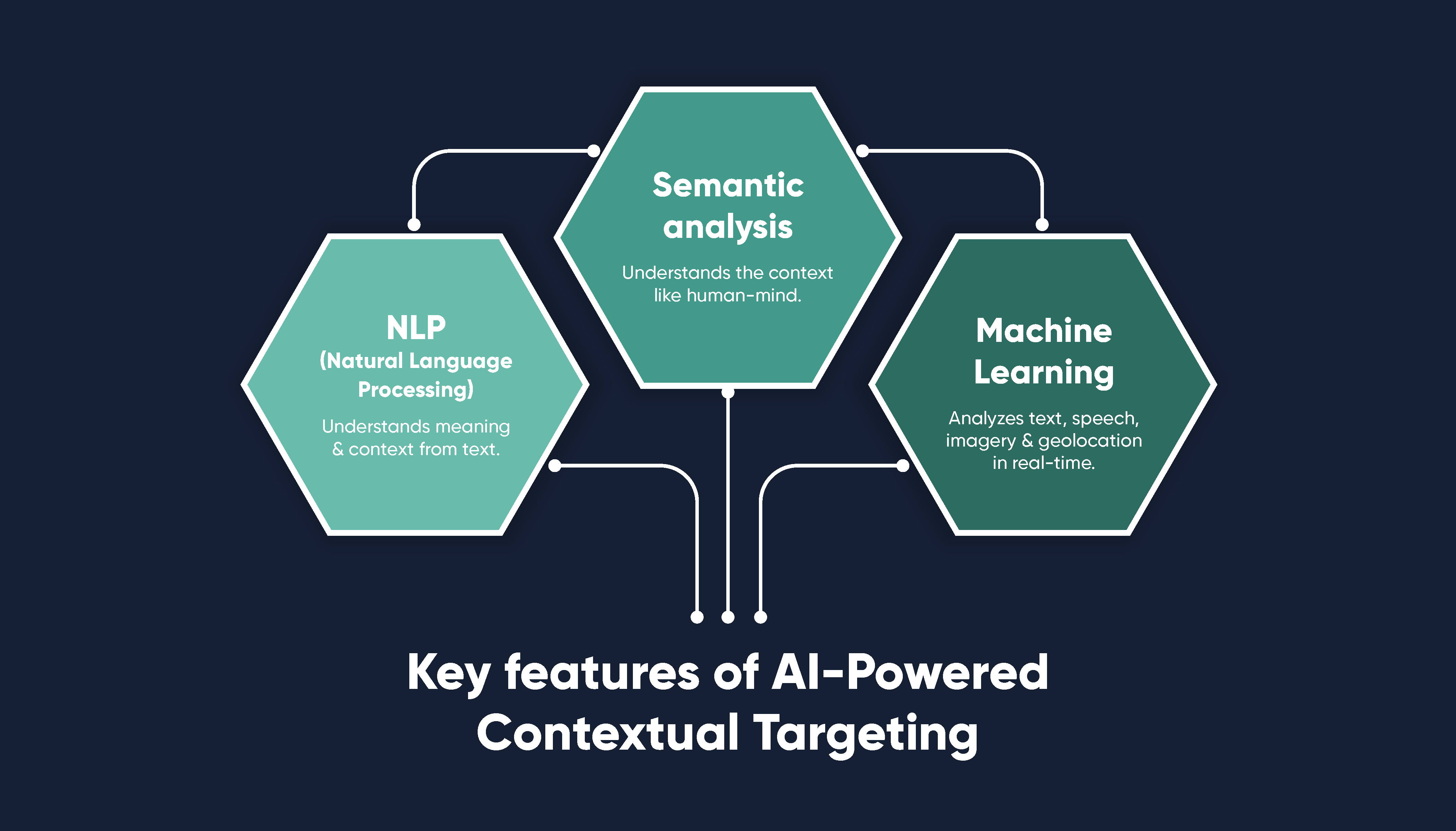
This evolution goes beyond traditional keyword targeting, employing NLP and semantic analysis to comprehend webpage content comprehensively, including text, images, and videos. Machine learning further enhances advertising opportunities by analyzing vast datasets, and predictive AI leverages existing consumer behavior data to inform targeted strategies.
Silverpush, through its advanced contextual targeting solution, Mirrors, adopts a dual approach. The AI-powered contextual solution identifies key contexts across webpages on the Openweb to extract contextual signals for advertising opportunities. Simultaneously, it conducts a thorough analysis of historical consumer behavior data, enabling predictions of audience personas and likely actions.
In a comprehensive view, Silverpush empowers advertisers to tap into previously unexplored market segments through its omnichannel contextual solution. This is achieved within a brand-safe and suitable environment, ensuring a holistic and effective advertising strategy.
Conclusion
In today’s digital world, advertisers use contextual targeting to reach specific audiences. Privacy is crucial, and transparency is key for advertisers to stand out. In the era without cookies, advanced contextual targeting is a safe and effective choice. It not only keeps users secure but also ensures brand safety. When ads are relevant to users, it greatly improves brand safety, giving advertisers a smart edge in today’s advertising landscape.
CTV Gold Rush: Capturing Audiences & Conquering Ad Fatigue
PUBLISH DATE: 11 December 2023
With viewers ditching traditional cable in favor of streaming services, advertisers are flocking to CTV to capture a captive and engaged audience. According to Insider Intelligence, US CTV ad spending is expected to reach $16.36 billion in 2023, accounting for 21.1% of all TV ad spending.
And this isn’t just a fleeting trend. CTV has officially surpassed traditional “linear” TV, leaving it in the dust. In fact, the number of CTV households is set to skyrocket, exceeding 115 million by 2024, more than double the number of linear TV homes.
What’s driving this shift? For advertisers, the answer is simple: CTV is a gold mine. Ad spend on linear TV is steadily declining, while CTV continues to soar, projected to increase by 21.2% year-on-year. And the numbers don’t lie – viewers are more likely to act on CTV ads, with a 23% higher purchase intent compared to linear ads.
However, with increased competition comes a new challenge: ad fatigue. Seeing the same ad repeatedly can lead to viewer apathy and a decline in engagement. To combat this, advertisers need to create dynamic and engaging CTV ad creatives that resonate with viewers
What is Consumer Fatigue?

Even in the captivating world of CTV, viewers can develop ad fatigue. This occurs when they’re repeatedly exposed to the same ad, leading to decreased attention and engagement.
Ad fatigue can seriously hinder the effectiveness of your CTV campaigns. It can lead to:
- Decreased brand recall: If viewers are constantly bombarded with the same ad, they’re less likely to remember your brand or message.
- Lower engagement: Viewer apathy towards repetitive ads translates to decreased interaction with your call to action.
- Negative brand perception: Constant exposure to the same ad can actually create a negative association with your brand in viewers’ minds.
To avoid these pitfalls, it’s crucial to diversify your ad creative and ensure viewers see fresh content regularly. Explore different formats, messaging approaches, and even target specific audiences with tailored ad variations. By keeping your CTV advertising engaging, you can maintain viewer interest and maximize campaign impact.
Why does it matter:
With the continuous expansion of ad-supported streaming services in the connected TV, the available advertising inventory is on the rise. However, gaining clear insight into the CTV ad supply chain remains a challenge, complicating efforts to implement effective frequency capping.
1. According to insider intelligence projections, by 2024, the number of viewers for free ad-supported streaming TV (FAST) is expected to reach 104.4 million, with ad-supported video-on-demand (AVOD) viewers reaching 180.2 million.
2. Aluma Insights reports that 40% of US adults have increased their time spent on FASTs in the past year.
3. The simultaneous growth of viewership and ad loads on both FAST and AVOD services has the potential to exacerbate ad fatigue.

1. Creative Variations:
A) Interactive Media: Play around with CTV Ads is an effective way to capture user attention & drive engagement with interactive video elements like attaching QR codes, in video texts.
B) Edit the Order of Footage: Re-sequence your existing footage to create a new narrative flow, highlighting different aspects of your product or service. This simple switch can offer a fresh perspective and enhance audience engagement.
C) Refocus Your Scenes: Shift the spotlight to specific scenes within your existing material. This allows you to explore alternative storytelling angles and emphasize different benefits for the viewers.
D) Tweak Your Call to Action: Encourage viewers to take action & utilize generative AI to get actionable CTA’S which resonates most effectively with your target audience.
E) Refresh Your Voiceover: Give your ad a new voice by changing the voiceover artist or adjusting the script’s tone and language. This can significantly impact the overall feel and message of the ad, potentially attracting new audiences.
2.Target Your Ads Precisely with frequency capping:
By setting a frequency cap on your CTV ads, you can ensure that they are not shown to the same viewer too often. This will help prevent ad fatigue and ensure that your ads remain engaging and effective.
Contextual relevance is key to engaging viewers and avoiding ad fatigue. This means tailoring your ads to the specific context in which it is being shown. This includes factors such as the:
A) Channel: What type of content is typically shown on this channel?
B) Program: What is the program about? What are the viewers likely to be interested in?
3. Keep it Fresh with Regular Rotation:
For advertisers aiming for an “evergreen presence,” simply creating several variations and running them on repeat won’t suffice. You need to strike a delicate balance between delivering consistent, memorable messaging while constantly innovating to stay fresh and prevent viewer fatigue.
This might involve subtle tweaks to visuals, messaging, or even the overall tone of your ads to keep them engaging even throughout a year-long campaign.
Highlight the power of seasonality to create timely and relevant messaging that resonates with viewers. Aligning your ads with key holidays, events, or cultural moments allows you to capitalize on existing trends and conversations.
4. Use Diverse formats with different ad lengths:
Not all viewers have the same attention span, so it’s important to test different ad lengths to see which ones perform best. This can help you find the sweet spot for your ads, ensuring that they are not too long or too short to be effective.
Ads can grab attention and tell a compelling story, while interactive ads offer a more engaging experience. Branded content allows you to subtly weave your brand message into existing content, creating a less intrusive and more natural experience.
Also Read:Unveiling the Real Potential of CTV for Marketers: Moving Beyond the Hype
CTV: The Future of Television and Avoiding Ad Fatigue
In conclusion, as Connected TV (CTV) continues to dominate the advertising industry, steering clear of ad fatigue emerges as a pivotal strategy for advertisers seeking optimal results.
By implementing dynamic and diverse ad creative strategies, such as interactive elements, strategic sequencing, and refreshed voiceovers, advertisers can combat viewer apathy and maintain high engagement levels. Precision targeting with frequency capping, adapting to contextual relevance, and utilizing diverse ad formats further enhance advertisers to get better results & high user interaction.
Beyond the Horizon: Forecasting Major Shifts in 2024’s Video Ad Landscape
PUBLISH DATE: 06 December 2023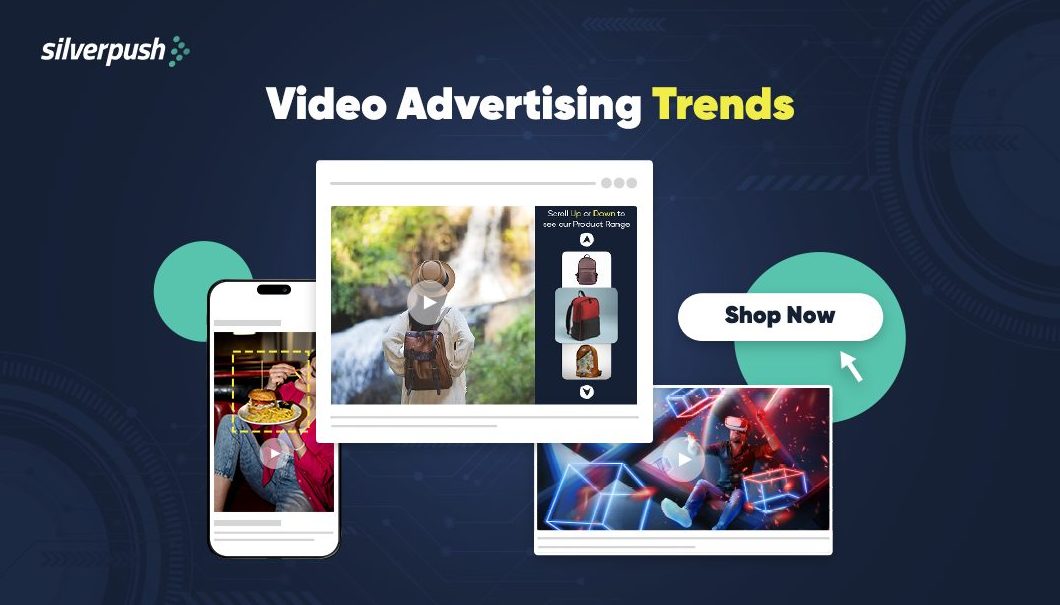
Video advertising has emerged as a pivotal element in the domain of content marketing strategy. Whether it’s a concise 30-second ad, an interactive campaign, or captivating live footage, integrated videos within your content stand out as a highly favored and efficacious means to captivate your audience.
Remarkably, video content is the preferred choice for 80% of individuals compared to traditional written text, and an impressive 87% of businesses are already using it as a potent marketing tool.
Research underscores that a compelling 88% of consumers have been swayed by marketing videos to make purchases of products and services. The undeniable power of video highlights the significance of grasping the latest trends in video marketing to maintain a competitive edge in 2024.
This blog aims to comprehend the trends that will shape the video advertising industry in 2024 and beyond. From the ascent of AI-powered advertising to the escalating importance of personalization, these trends are bound to redefine how marketers engage with their audience and orchestrate successful video ad campaigns.

1. Growing Integration of AI in Video Advertising:
The landscape of video advertising is swiftly evolving with the increasing integration of Artificial Intelligence (AI). Anticipate a surge in businesses adopting AI to produce and disseminate video content. With AI’s remarkable capacity to analyze extensive datasets rapidly, advertisers can:
A) Enhance their understanding of the audience
B) Fine-tune ad delivery
This approach ensures that the right message reaches the appropriate audience at the optimal moment. This, in turn, facilitates the creation of more compelling and pertinent video content that resonates with the target audience.
For instance, generating videos featuring available or customized avatars, where text input is the sole requirement. This proves advantageous for cost-effective video marketing when in need of a character but faced with constraints in time or resources for large-scale video production, employing text-to-speech, or automated voices.
Additionally, AI’s role in programmatic advertising is assuming a pivotal role. Fueled by AI algorithms, automated ad purchasing and placement will restructure the industry through real-time bidding and ad optimization.This results in more efficient ad campaigns with heightened conversion rates. In 2024, Artificial Intelligence is not merely a passing trend but a transformative force poised to reshape the video advertising industry.
2. Augmented Reality & Virtual Reality:
The year 2024 will witness a paradigm shift in video ads through the integration of Augmented Reality (AR) and Virtual Reality (VR). AR advertising overlays digital elements onto the real world, creating an interactive platform for crafting captivating campaigns.
These ads enable users to seamlessly merge the virtual and physical realms, fostering deeper engagement and memorable brand interactions. Conversely, VR advertising immerses users in entirely digital environments, providing a distinctive storytelling medium suitable for product demonstrations and brand narratives.
The ability to create immersive ad experiences holds the potential to captivate audiences, setting your brand apart from competitors in a landscape where traditional advertising methods might no longer be as effective.
This innovative approach pledges to deliver campaigns that are not merely viewed but profoundly experienced by consumers. As the future of advertising veers towards interactivity, encompassing the AR and VR advertising wave signals that your business is leading the way in innovation and adopting superior business practices.
3. Contextual Advertising for Enhanced Relevance:
Contextual advertising remains a significant tool for marketers in 2024. Global spending on contextual advertising is projected to reach $227.38 billion in U.S. dollars in 2023, and this figure is anticipated to more than double by 2030, reaching an estimated $562.1 billion.
The United States stands as the world’s largest contextual advertising market, with a market value of approximately $65 billion in 2022. This type of advertising places ads based on the surrounding content, resulting in a smoother and less disruptive ad experience.
Amidst rising ad blocking and privacy concerns, contextual advertising offers a solution that respects user preferences while delivering relevant content. As user expectations for personalized advertising increase, marketers can anticipate more of this approach.
To thrive in contextual advertising, marketers must meticulously align their ads with the context to enhance the user experience. This trend strongly emphasizes quality content and strategic placement over sheer volume. This can be achieved by researching and understanding the target audience, as well as identifying the most relevant keywords and phrases to include in the ads.
4. Short-Form Video Content: A Dominating Force
In 2024, short-form video ads are projected to dominate video advertising, accounting for a significant portion of ad spend. Advertisers are likely to capitalize on the format’s effectiveness in conveying concise yet impactful messages.The brevity of these ads aligns seamlessly with the reduced attention spans of today’s audiences, making them a powerful tool for brand communication.
In 2023, programmatic short-form video ad spending is expected to reach a staggering $12 billion, a 50% increase from the previous year. This explosive growth isn’t just a fleeting trend; it’s a fundamental shift in how consumers engage with video.
This shift has profound implications for 2024’s video ad landscape. Expect to see an abundance of short-form video ad formats, optimized for mobile viewing and lightning-fast storytelling.Programmatic platforms will adapt, providing granular targeting and real-time analytics to help brands reach the right audience with the right message at the right micro-moment.
5. Shoppable Ads:
Shoppable ads are an innovative format that allows viewers to purchase products directly from video ads. By incorporating eye-catching product imagery alongside video ads, brands can inspire viewers and direct them to specific product pages on their website, creating a seamless path to purchase.
According to Think with Google, brands that utilize product feeds in their video action campaigns achieve over 60% more conversions at a lower cost. Video action campaigns can help scale video ads automatically across various platforms, including the home feed, watch pages, connected TV, and search. They utilize machine learning to drive conversions and provide valuable attribution insights.
To implement shoppable ads, brands can attach a product feed from the Google Merchant Center. This allows viewers to browse products directly within the video ad and seamlessly navigate to the corresponding product pages on the brand’s website for purchase.
Wrap Up:
In conclusion, the video advertising industry is up for a significant shift in 2024 and beyond. The integration of AI, AR, and VR will reshape how brands engage with their audience and create captivating ad experiences.
Contextual advertising remains a valuable tool, while short-form video content and shoppable ads will gain prominence. By utilizing these trends, marketers can effectively capture attention, drive conversions, and establish a competitive edge in the ever-evolving world of video advertising.
What are Instream Video Ads & What’s so great about it?
PUBLISH DATE: 22 November 2023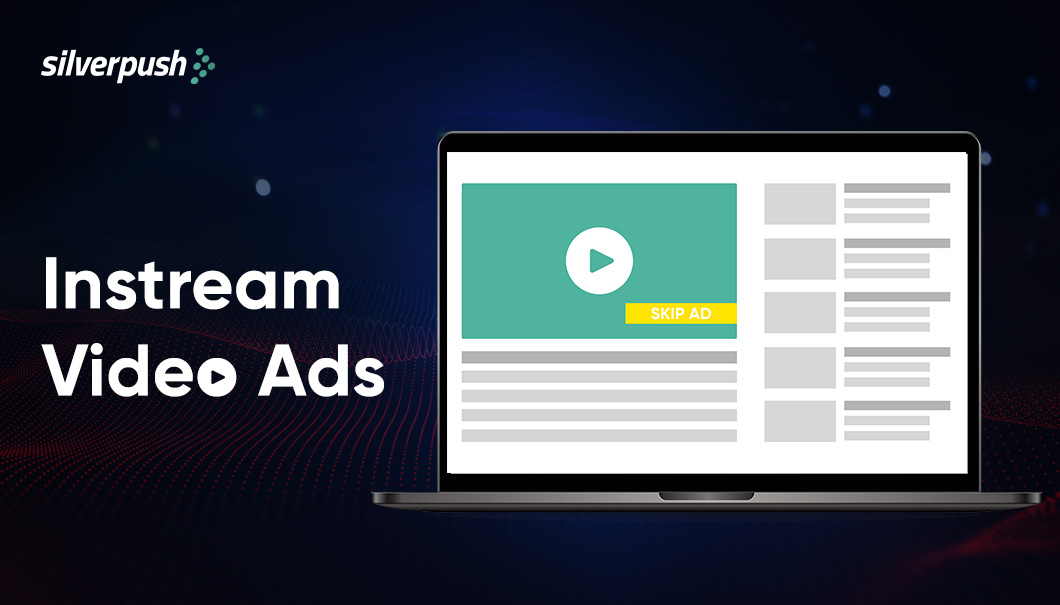
Navigating the marketing industry can be daunting with its ever-evolving landscape of acronyms and dynamic definitions. The latest puzzle to unravel? Instream video.
To empower marketers, let’s delve into what are Instream video, highlighting recent updates, the pros and cons, aiding in an informed decision tailored to specific marketing goals and target audiences.
What are Instream Video Ads Anyway?
Historically, these ads play within an existing video stream and can be classified as pre-roll, mid-roll, or post-roll ads.
Pre-Roll Instream Ads
Display before a video starts.
Mid-Roll Instream Ads
Interrupt the viewing experience, often in longer content with a high completion rate due to viewer engagement.
Post-Roll Instream Ads
Appear when a video concludes, offering a better user experience but with lower effectiveness.
Furthermore, instream video ads come in two primary formats: non-skippable and skippable, each with distinct viewer interactions. Non-skippable ads demand the audience’s full attention, playing in entirety before granting access to the desired video content. On the flip side, skippable ads offer viewers the flexibility to bypass the advertisement after a set duration, typically around five seconds.
These ads present advertisers with a valuable opportunity to connect with a diverse audience, engaging them during active video consumption. Striking a delicate balance between conveying the message effectively and respecting the viewer’s experience is crucial for advertisers. This equilibrium ensures a positive reception of the ads, enhancing the overall impact of their marketing efforts.
When it comes to video ads, people tend to find pre-roll ads less annoying than others, according to a study. The research showed that 69% of folks could remember a pre-roll ad, while only 41% could recall a mid-roll ad.
Also Read: Video Contextual Advertising: Everything You Need to Know
Pros of Instream Ads
Captivated Audience:
Leveraging instream ads capitalizes on the fact that viewers are already primed for video content, actively seeking and engaging with it. Whether at the beginning, middle, or end of a video, the audience is comfortably tuned in, with audio on, creating an opportune environment for your message.
Motivated Engagement:
Particularly with non-skippable pre-rolls and mid-rolls, viewers have a compelling reason to stay engaged—they want to return to their initial content. This inherent motivation, coupled with sophisticated retargeting, can enhance their viewing experience and increase the likelihood of exploring your product or service further.
Cons of Instream Ads
Limited Placement Options:
An inherent drawback of instream ads lies in the limited array of platforms available for marketing. While major platforms like YouTube and Facebook are prominent choices, businesses targeting B2B clients or demographics less active on social media may find their options constrained.
Perceived Intrusiveness:
Instream ads are encountered by users who have not necessarily chosen to watch them, potentially rendering them as intrusive or bothersome. The lack of explicit user consent may contribute to a sense of interruption, impacting the overall viewer experience.
More Recent Updates for Advertisers
In the OpenRTB 2.6 specifications from the IAB Tech Lab, a new classification for Instream and other video ads emerged…
- Instream: Played before, during, or after requested video content, with sound on.
- Accompanying Content: Pre-, mid-, or post-roll ads within editorial content, playing automatically without sound.
- No Content/Standalone: Video ads independent of specific content, shown in video players playing only ads.
- Interstitial: Full-screen video ads on the web and in-app.
Next Steps
Given video’s effectiveness, staying informed is crucial. Adapting to the new classification system is paramount, and Crafters is here to help.
To discover how we can support you in navigating this evolving landscape and achieving your business goals, reach out to us.
$5.6 billion of digital ad spend was wasted in 2022: Are you Doing it Right?
PUBLISH DATE: 17 November 2023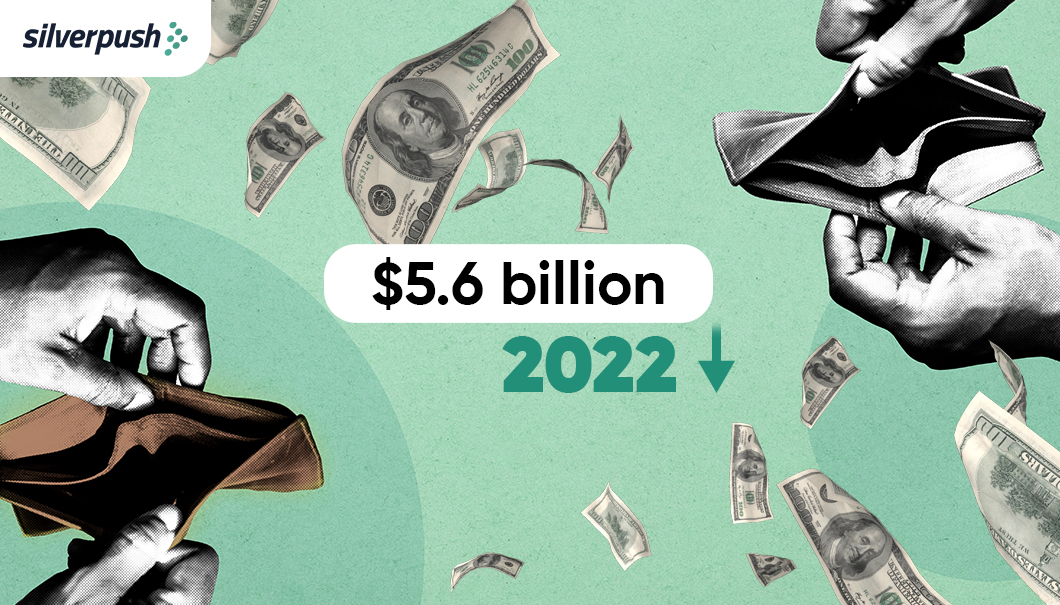
As someone who creates a bunch of ads, both traditional ones and some really out-there experimental ones, you’ve always had this nagging question in your head. It’s like, are your efforts actually hitting the mark, or are they just disappearing into the online void?
According to a report of Digital Media Wastage by Next&Co’s, a staggering $5.6 billion of digital ad spend was wasted in 2022, constituting 41% of the total digital ad spend. Specifically, in the realm of connected TV, LG Ads discovered that brands often allocate 50% of their campaign budget to target just 10% of the available audience.
Against the backdrop of current economic uncertainty, the urgency to address media wastage becomes even more apparent. It is crucial to invest each dollar intelligently, ensuring that it delivers maximum value.
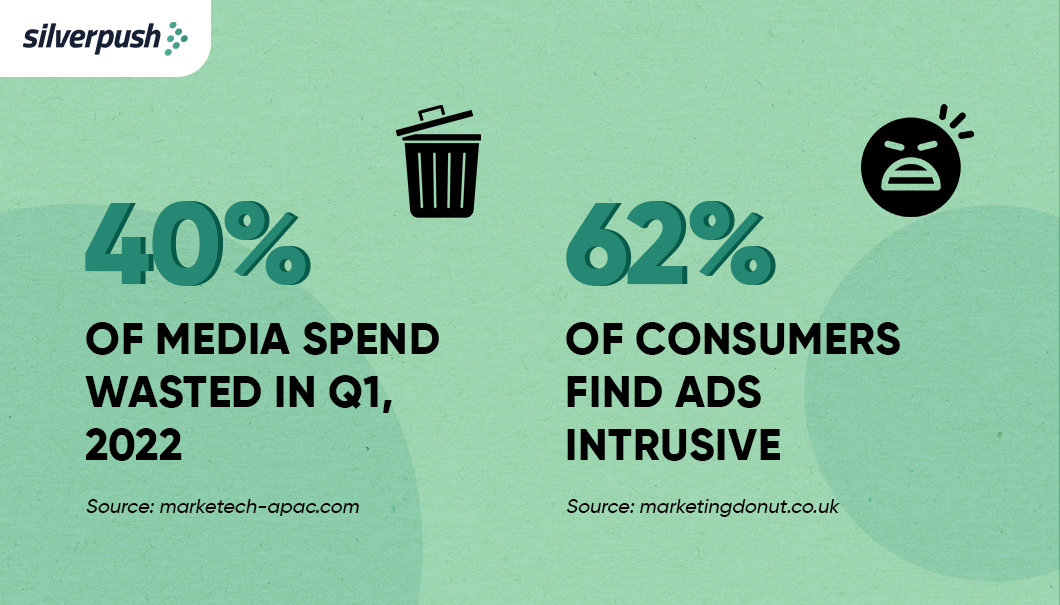
What does “media wastage” actually mean?
To put it simply, media wastage means utilizing your marketing budget to reach consumers who aren’t your intended audience. It’s like buying winter coats for people living in a tropical climate – not the most efficient use of your resources, right? Media wastage can mess up any digital campaign, whether it’s a pay-per-click or a video ad, so everyone needs to watch out for it.
And it’s not just about the money. Ads placed alongside misaligned content can actually make consumers less likely to buy, whereas matching ads with the right context can boost the likelihood of purchase by 8%.
Now, I can almost hear you asking: “If my ad ends up reaching folks who aren’t really interested in my product, how much damage could it really do?” In the world of marketing, every cent matters. Especially, when we are talking about billions of dollars going down the drain every year, it’s not just a small problem. It’s like a big wave that’s sweeping away potential returns – your potential returns.
How to Maximize Impact and Reduce Media Wastage from your Advertising Campaigns?
It’s not only about showcasing your creative skills or staying in sync with the newest trends; it’s also about effectively managing your resources. As mentioned earlier, every dollar wasted in media inefficiency could have been used for a more targeted and influential campaign. That money could have gone into improving your product or elevating the overall customer experience.
Beyond One Size Fits All: Mastering Audience Reach with Custom Creatives
Effectively connecting with audiences through personalized creative content is crucial. According to a study by Barraza, contextually aligned ads were 93 percent more memorable than misaligned ads. Thus, it clearly depicts that aligning ads with congruent content, rather than simply placing ads where there are larger audiences, ensures a higher return on investment.
By utilizing top-notch brand suitability and contextual targeting technologies like Silverpush, brands and advertisers can be confident that their purchased impressions match with the most fitting content. This strategic approach ensures that every dollar spent yields the maximum number of positive impressions through brand suitability and contextual targeting.
It’s essential for brands to recognize that the era of niche targeting is here. Campaigns now focus on delivering custom-made creativity to smaller, niche audiences through brand suitability, contextual targeting, and inclusion lists. Audiences respond more positively to advertising content that resonates with their interests, while a broad approach only results in wasteful spending.
Inclusive Precision: The Path to Sustainable Advertising and Waste Reduction
In an era of careful advertising, some brands and advertisers have avoided addressing crucial topics such as race, gender, and religion by using block lists. Unfortunately, this approach also results in creators focusing on these issues, mainly from diverse communities, being blocked, leading to the exclusion of their content from reaching diverse audiences.
The significance of diverse audiences cannot be overstated. Overly cautious block lists have, for too long, prevented these potential audiences from engaging with brands’ content. According to a new survey from Top Design Firms, nearly two-thirds of consumers (64%) are at least somewhat likely to purchase a product immediately after seeing it advertised if the brand embodies diversity and inclusion.
Developing customized and well-researched inclusion lists enables brands and advertisers to support diverse creators and audiences. Investing in diverse audiences through inclusion lists not only aligns with the principles of inclusion and diversity but also proves financially beneficial by reducing media wastage.
Aligning Your Message with Consumer Preferences
While progress has been made in addressing underrepresentation in video advertising content, the issue of media wastage extends beyond mere representation. It’s time for brands and advertisers to adopt diverse and conscious strategies in every aspect of their campaigns, from building and ideation to targeting and brand suitability methodologies.
For multicultural marketers, being able to rely on high quality ad tech that can help you identify and target your chosen audience is a must. This means looking for partners that not only have firsthand experience and expertise working with the audiences you’re trying to attract but also have a sophisticated platform that will enable you to reach them at scale.
Mirrors’s cutting-edge AI-powered technology uses a combination of contextual signals to reach your most relevant consumers at the right moment/context. The cutting-edge visual intelligence identify multicultural triggers that can work wonders for your ad campaign:
Faces of micro-influencers – Due to their ability to connect with niche communities and engage with their followers on a more personal level, brands can leverage Mirrors hyper contextual targeting solution to identify key contexts like celebrities of micro-influencers for a high level of engagement.
Logos of minority communities-owned brands – By identifying key contexts like brands of minority community-owned brands, channels & other relatives in your advertising demonstrate a commitment to representation and inclusivity. It sends a strong message that your brand supports and values diversity, which can resonate positively with multicultural audiences.
Language – Recognizing the linguistic diversity within multicultural communities is important and audiences seek out brands that localize their content to give it a more personal touch. Language-specific advertising demonstrates respect for cultural diversity and enhances the overall impact of the campaign.
Regional channels – Regional channels often create content that is specific to the local culture, language, and interests of their audience. By advertising on these channels, brands can align their messaging with the cultural context and create content that resonates with the viewers. This relevance enhances the effectiveness of the advertising campaign and fosters a stronger connection with the target multicultural audience.
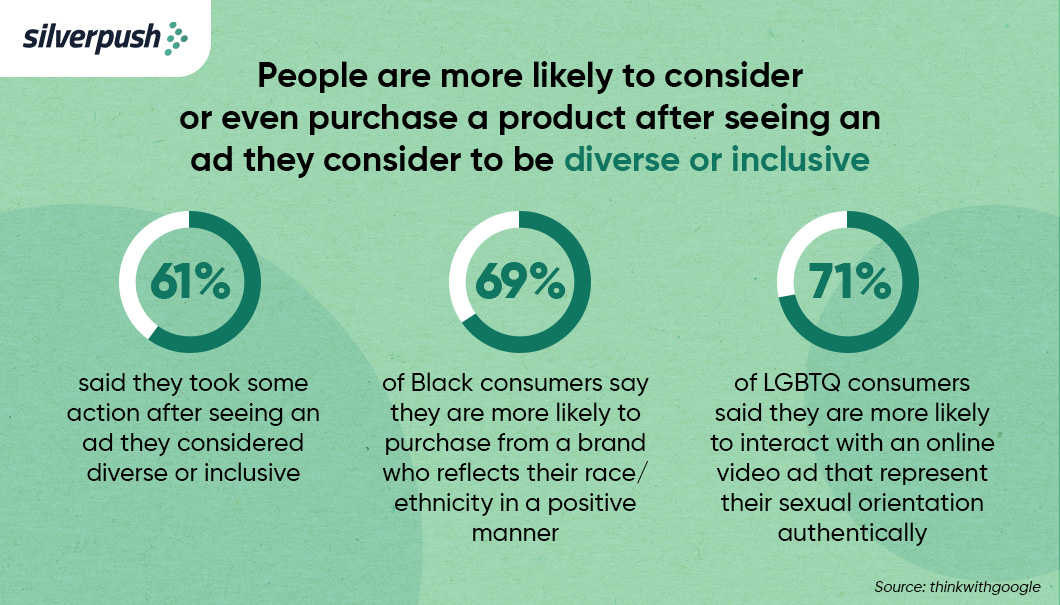
These considerations go beyond words and contribute to the impactful social messages brands convey, all while maximizing the ROI for campaigns.
Media wastage is a widespread industry challenge, but addressing it requires a reassessment of advertising practices. An essential step is ensuring a brand’s content resonates with the correct audiences through high-standard brand suitability and contextual advertising. Brands and advertisers should break free from the constraints of cautious advertising by embracing more rewarding inclusion lists. Taking a conscious and holistic approach to advertising is crucial for reducing media wastage and fostering a positive advertising ecosystem for everyone involved.
Want to cut down on media waste and boost your ad campaigns’ ROI? Reach out to us to get started!













